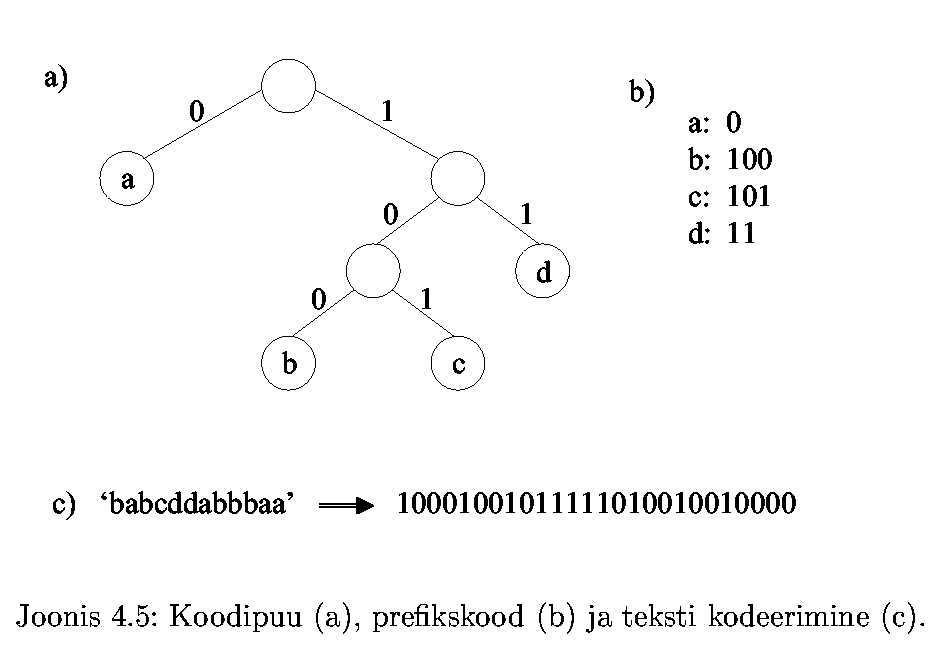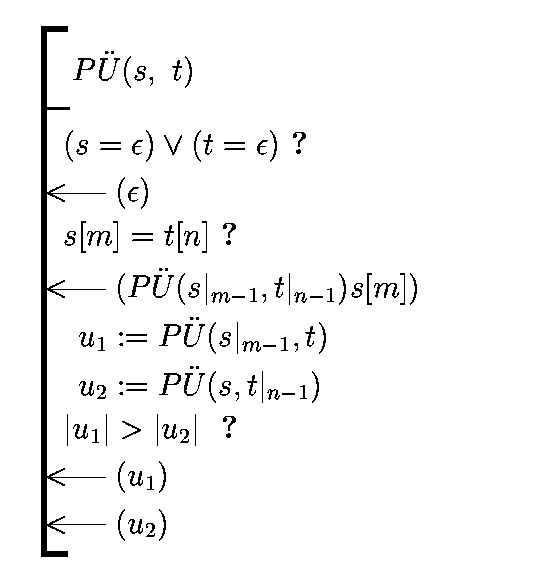Text
Processing - Coding and Compressing
Greedy
Strategies and Dynamic Programming
Encoding
objectives: compression, error correcting, cryptology, ... Coding
scheme: alphabet-based coding scheme (vs dictionary based or block
encoding), single-valued (unique) coding scheme (vs lossy).
Prefixcode, 0-1 prefixcode. Code tree for a prefix code.
Compression using variable length code. Huffman code and Huffman
algorithm (greedy). Encoding (compressing) and decoding
(decompressing) using Huffman codes. Other methods for
compression. Shannon-Fano method.
Dynamic programming. Fibonacci sequence. Longest common
subsequence problem.
Coding and Compressing
Coding in general
- Data compression (packing, e.g. Shannon-Fano, Huffman and
Ziv-Lempel codes)
- Correcting transmission errors (e.g. Hamming code)
- Cryptography (secret and public key cryptography, digital
signatures, watermarks, fingerprints, etc.)
- ...
Coding scheme is a
mapping from source text to coded text.
Alphabet-based coding scheme maps each symbol
separately - symbols have codes.
If the source text is uniquely retrievable from the coded text,
then the coding scheme is called single valued (unique).
Single-valued coding scheme does not cause data
loss. Multimedia coding schemes are often lossy (e.g. mp3).
Single-valued alphabet-based coding scheme has the
following properties:
- codes of different symbols are different
- in coded text there is exactly one possible way to decode
it (two different source texts cannot produce the same coded
text).
Example of such a scheme is a
prefix code: any code is not a prefix of any other code.
Let us have a look at binary code (0-1).
Prefix code to produce the binary code (0-1 prefix code)
can be expressed as a binary tree: moving to left subtree adds 0
to the code, moving to right subtree adds 1 to the code, leaves
contain symbols, coding starts from the root node.
This code tree represents a prefix code,
because:
- different symbols reside in different leaves of the
code tree, path from root to leaf is unique for each symbol
- no code can be prefix of any other code, because all
true prefixes reside in intermediate (inner) nodes of the
code tree
Example: ASCII-7 code tree is a perfect binary tree
with 7 levels (each symbol has a different 7-bit code).
Compressing
Idea: variable code length
allows text compressing, if we give to frequent symbols shorter
codes and to less frequent symbols longer codes.
To implement such a coding scheme we need to know the
frequencies of the symbols.
In terms of 0-1 prefix code tree the frequent symbols
must be closer to the root node, less frequent symbols can be
deeper:
 Huffman coding tree provides the optimal
prefix code for a given text (no other coding is shorter).
Huffman coding tree is constructed using the
following algorithm:
Huffman coding tree provides the optimal
prefix code for a given text (no other coding is shorter).
Huffman coding tree is constructed using the
following algorithm:
- Pre-processing: find all different symbols
in the text and for each symbol its frequency. We can skip
pre-processing and use some language based estimate, but
then the optimality is not guaranteed.
- Build the leaves of the Huffman tree: for
all different symbols store the symbol and its frequency in
the leaf node. Add all leaves to some dynamic priority
queue, that holds root nodes of tree fragments. Each root
node contains frequency (sum of frequences of leaves in that
fragment).
- While there are at least two nodes in the
queue:
- choose and remove a node with smallest
frequency from the queue
- choose and remove another node with
smallest frequency
- build a new local root node and add
removed nodes as children to this root node
- add frequences of children and store the
sum as frequency of the root node
- add root node to the queue
- If only one root remains in the queue,
remove it and return as the root of the Huffman tree.
This is an example of a greedy algorithm:
globally optimal result is achieved using "greedy" local
choices.
Huffman (byte[] original) {
// initialization of leaves -
there are 256 possible bytes
leaves = new Node [256];
for (int i=0; i<256; i++) {
leaves [i] =
new Node();
leaves
[i].left = null;
leaves
[i].right = null;
leaves
[i].symbol = (byte)(i-128); // Java specifics - signed bytes
leaves
[i].frequency = 0;
}
// calculate frequencies
if (original.length == 0) {
root = null;
return;
}
for (int i=0;
i<original.length; i++) {
byte b =
original [i];
leaves
[b+128].frequency++;
}
// build the tree
LinkedList<Node> roots =
new LinkedList<Node>();
for (int i=0; i < 256; i++)
{
if
(leaves[i].frequency > 0)
roots.add (leaves[i]); // initial fragments
} // for i
while (roots.size()>1) {
Node least1 =
removeSmallest (roots);
Node least2 =
removeSmallest (roots);
Node newroot
= new Node();
newroot.left
= least1;
newroot.right
= least2;
newroot.frequency = least1.frequency + least2.frequency;
roots.addLast
(newroot);
}
root = (Node)roots.remove (0);
// Calculate the codes ...
}
There are other compressing
methods: e.g. replace repeating sequences by pair <number,
sequence>, in case of two levels it is sufficient to store
numbers only.
1111111000111100000000000011111111: 7,3,4,12,8
Shannon-Fano method: bisection
of symbol sets
Ziv-Lempel method is adaptive - coding scheme is vocabulary
based and it is created dynamically during processing the
source text.
Lossy compression - multimedia.
Steganography.
Dynamic Programming - Longest
Common Subsequence
Subsequence of a string of length n is any string that is
composed from remaining parts of the string after leaving out
some (from 0 to n) symbols. There are 2n different subsequences in
the worst case (when all symbols in the string are different).
Empty string and the original string itself are also considered
to be subsequences.
Example: "ABCD" has 16 subsequences:
empty, A, B, C, D, AB, AC, AD, BC, BD, CD, ABC, ABD, ACD, BCD,
ABCD
Let us have two strings: s of length m and t of length n. Find a
string u of length k such, that u is a subsequence for both
strings s and t (common subsequence) and k is maximal
(from all possibilities). String u is not uniquely defined
(sometimes there are many longest common subsequences), but the
length k is unique.
Notice the following:
- If s = s'X and t=t'X end on the same symbol
X, u also has to end on this symbol (otherwise u is not the
longest, because we can make it longer by adding symbol X to
the end). We can now reduce the problem to shorter strings (where
the last symbol is removed) s' and t' and append X to the
solution of the shorter problem.
- If s = s"Y and t=t"Z end on different
symbols Y and Z, we have two possibilities to reduce the
task to a simpler case:
- solve the problem for strings s and
t" (maybe t" ends on Y and we can use step 1, but
there is no problem if we cannot make lcs longer - we can
still use this reduction)
- solve the problem for stings s" and t
(maybe s" ends on Z ...)
- choose, which of these two is longer
Worst case is the empty sequence (nothing in
common, k=0), best case is s=t=u (k=m=n).
The following (extremely unefficient) recursive algorithm finds
a solution:
 We can remove the inefficiency if we use dynamic
programming - method to construct a solution to the
problem from (already stored) solutions to smaller problems.
We can remove the inefficiency if we use dynamic
programming - method to construct a solution to the
problem from (already stored) solutions to smaller problems.
We have seen this technique when we calculated Fibonacci
numbers:
f(0)=0
f(1)=1
f(n)=f(n-2)+f(n-1)
For longest common subsequence problem we use two matrices: one
keeps track on solutions of smaller problems (lengths) and other
is used to memorize the way the solution was calculated. Time
complexity to calculate these tables is O(m*n).
/** Finding the longest common subsequence (LCS) of two
strings.
* @author Jaanus
*/
public class Subsequence {
/* source data */
public static String s, t;
public static int m, n;
public static int[][] c, b;
public static String lcs;
/** Main method. */
public static void main (String[] args) {
if (args.length > 1) {
s = args[0];
t = args[1];
} else {
s =
"yywzxyx";
t =
"xxyzywxy";
}
m = s.length();
n = t.length();
c = new int[m+1][n+1];
b = new int[m+1][n+1];
System.out.println ("s = " +
s);
System.out.println ("t = " +
t);
program();
System.out.println();
System.out.print
(" ");
for (int j=0; j <
t.length(); j++)
System.out.print (t.charAt (j) + " ");
for (int i=0; i < c.length;
i++) {
System.out.println();
if (i > 0)
System.out.print (s.charAt(i-1) + " ");
else
System.out.print (" ");
for (int j=0;
j < c[i].length; j++) {
System.out.print (c[i][j] + ";" + b[i][j] + " ");
}
}
System.out.println();
int answer = c[m][n];
System.out.println ("Answer: "
+ answer);
for (int i=0; i <= m; i++) {
for (int j=0;
j <= n; j++) {
if (c[i][j]==answer && b[i][j]==1) {
findSolution (i, j);
System.out.println (lcs);
}
}
}
}
/** Dynamic Programming. */
public static void program() {
for (int i=0; i < c.length;
i++) c[i][0] = 0;
for (int j=0; j <
c[0].length; j++) c[0][j] = 0;
for (int i=1; i < c.length;
i++) {
for (int j=1;
j < c[0].length; j++) {
if (s.charAt(i-1) == t.charAt(j-1)) {
c[i][j] = c[i-1][j-1] + 1;
b[i][j] = 1; // increase lcs
} else {
if (c[i-1][j] > c[i][j-1]) {
c[i][j] = c[i-1][j];
b[i][j] = 2; // same column
} else {
c[i][j] = c[i][j-1];
b[i][j] = 3; // same row
}
}
}
}
}
/** Read the solution from the table position i,
j */
public static void findSolution (int i, int j) {
StringBuffer sb = new
StringBuffer();
while (i > 0 && j
> 0) {
if (b[i][j]
== 1) {
i--; j--;
if (s.charAt (i) != t.charAt (j))
throw new RuntimeException ("Error " + s + " " + t);
sb.append (s.charAt(i));
} else {
if (b[i][j] == 2) {
i--;
} else {
if (b[i][j] == 3) {
j--;
} else {
throw new RuntimeException ("Error " + s + " " + t);
}
}
}
}
lcs = sb.reverse().toString();
}
}
 Code
Code
Jaanus Pöial


